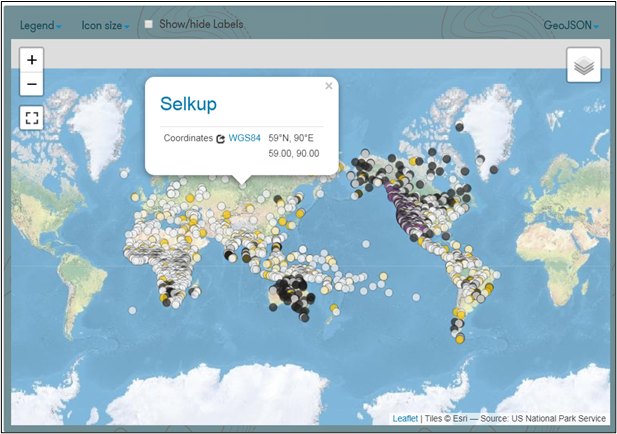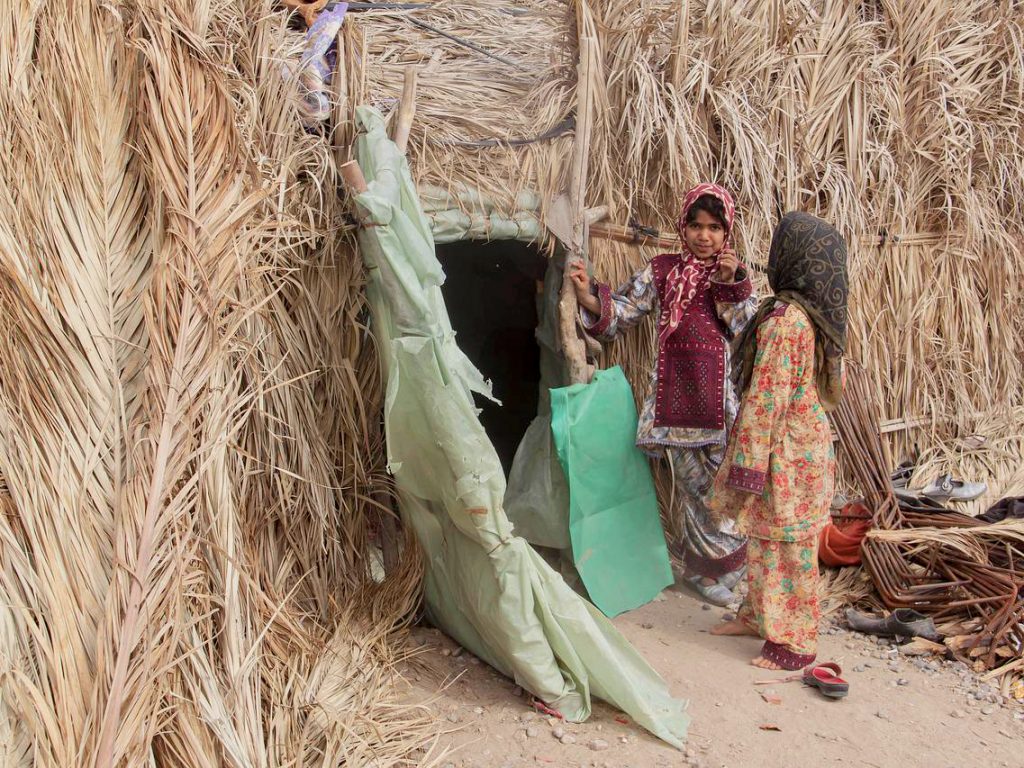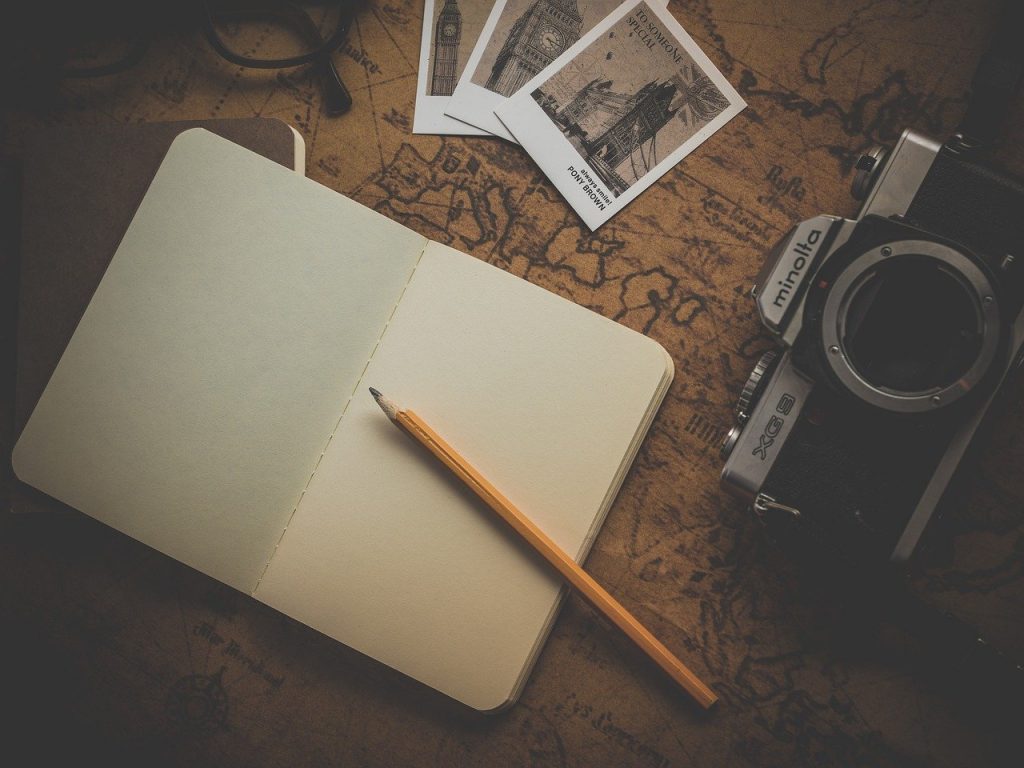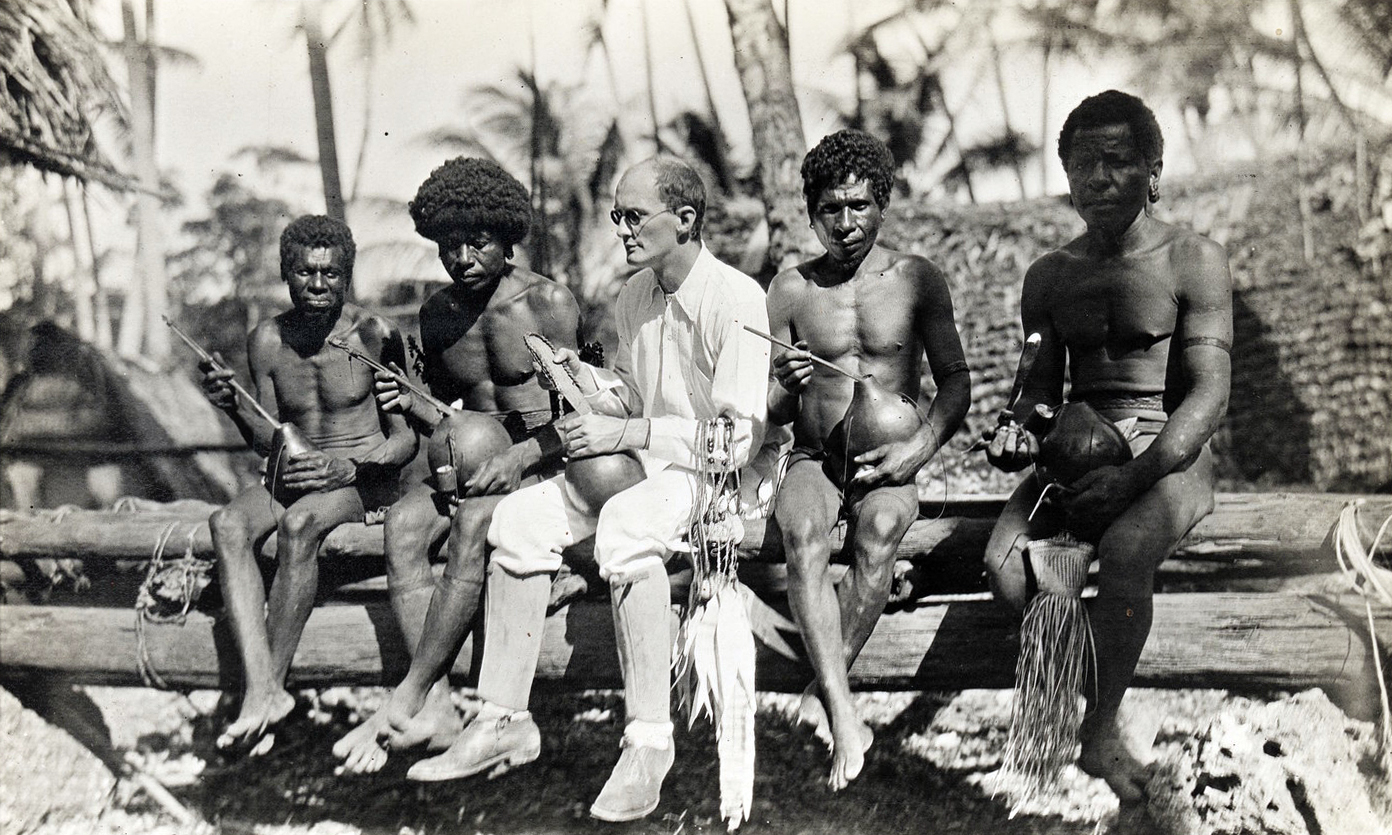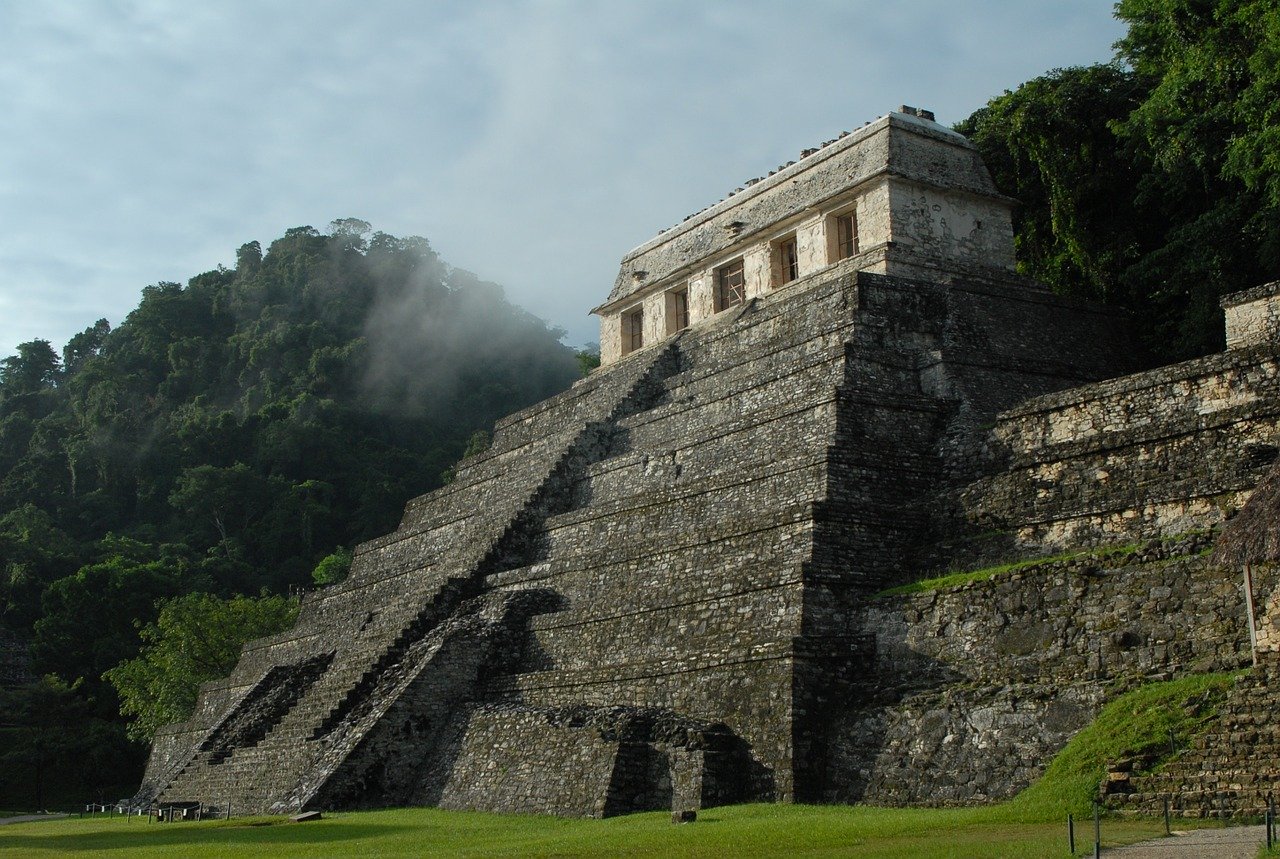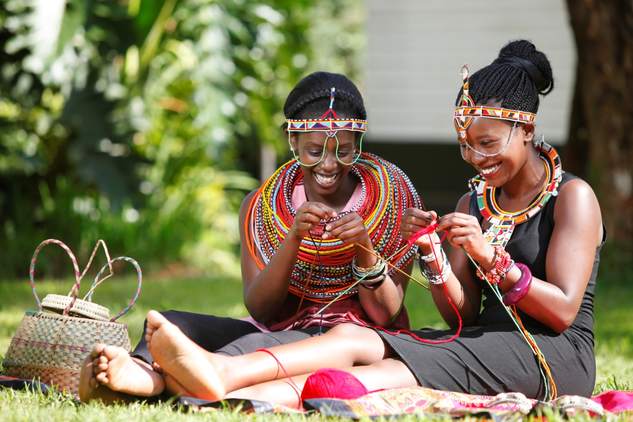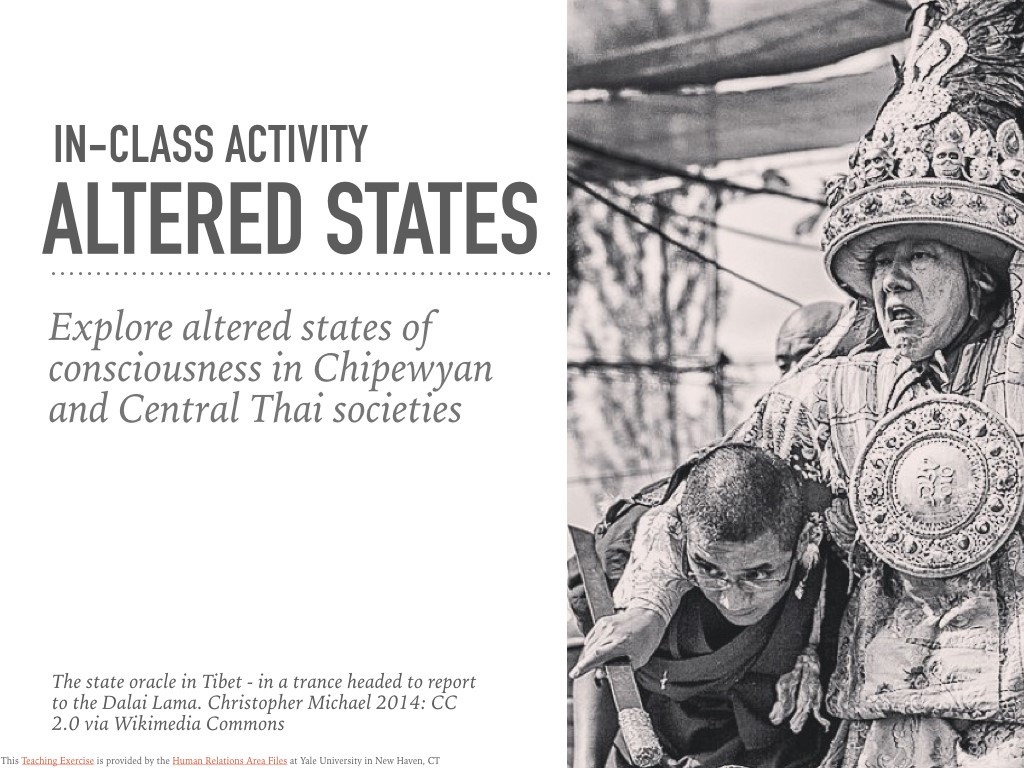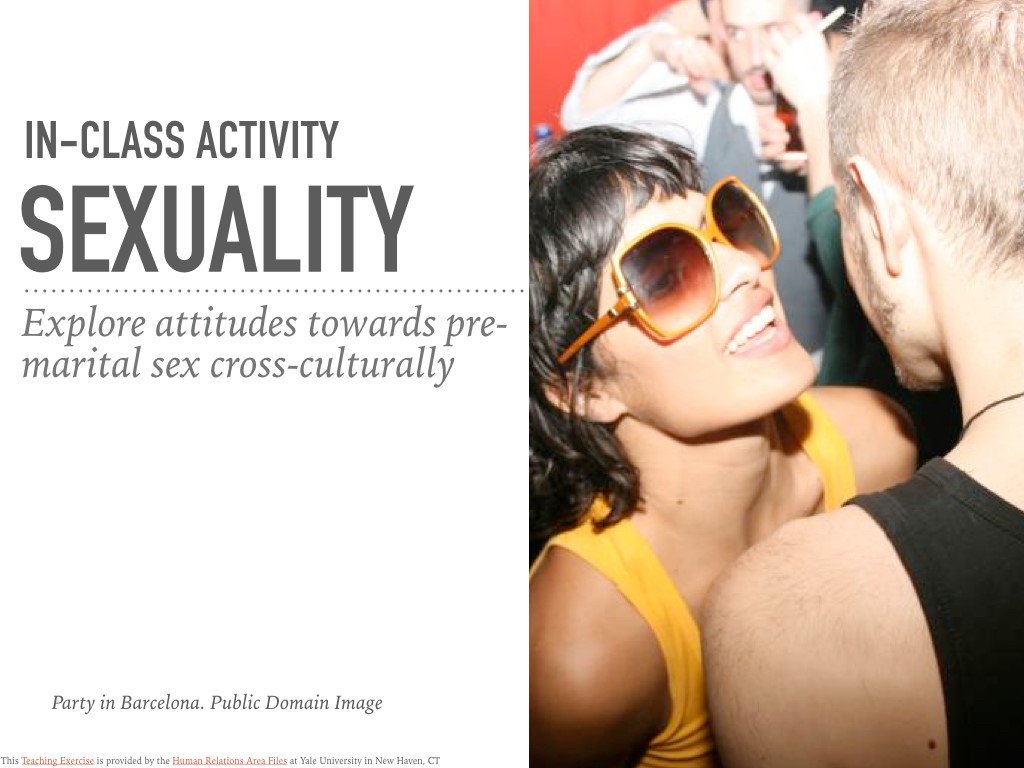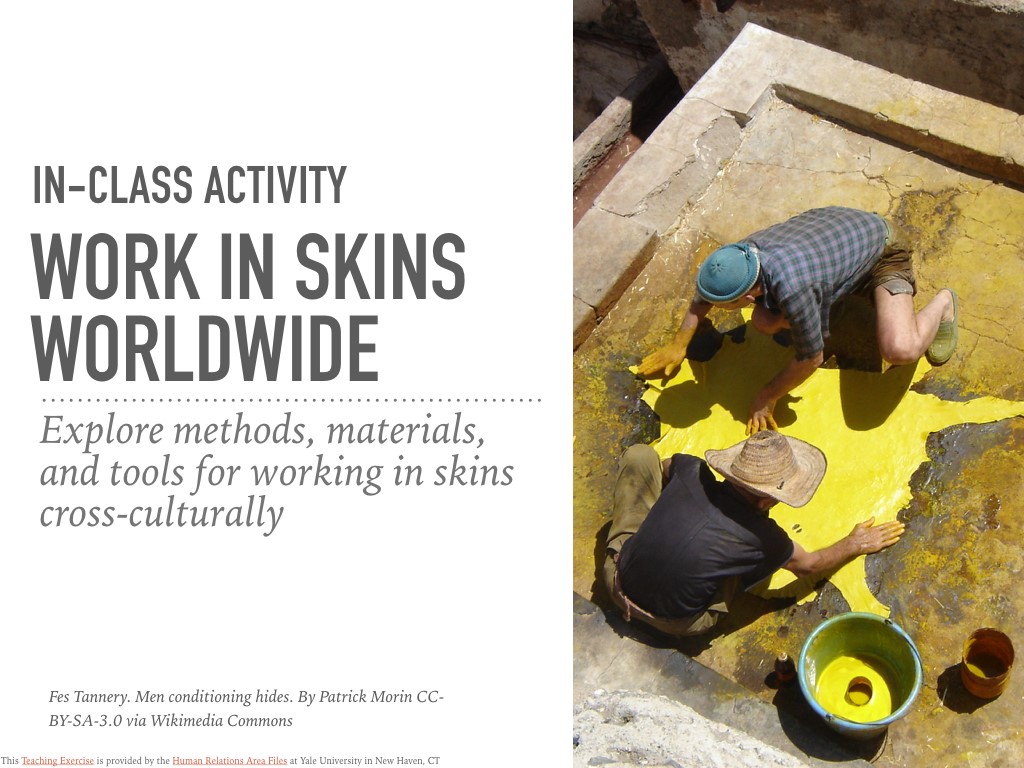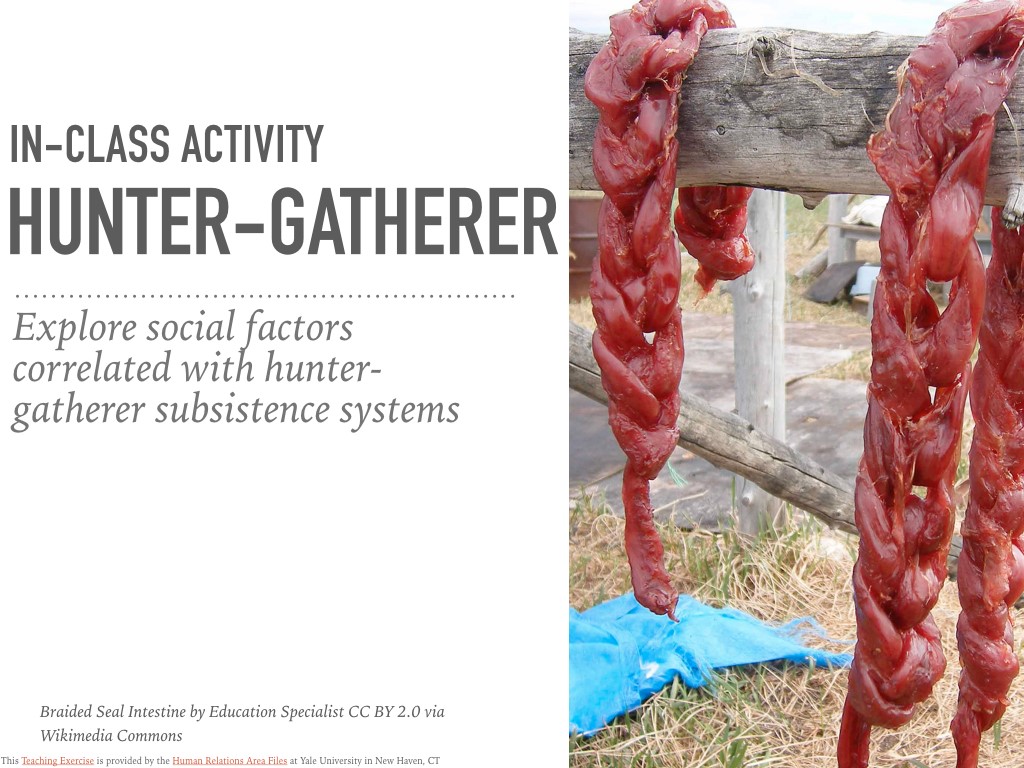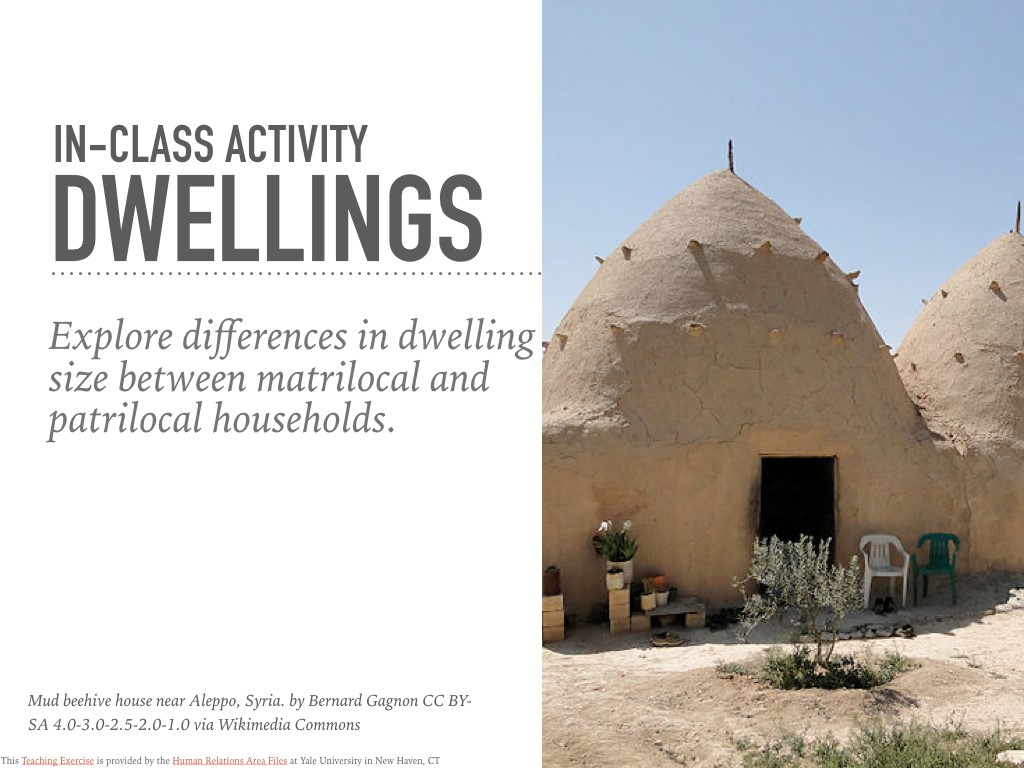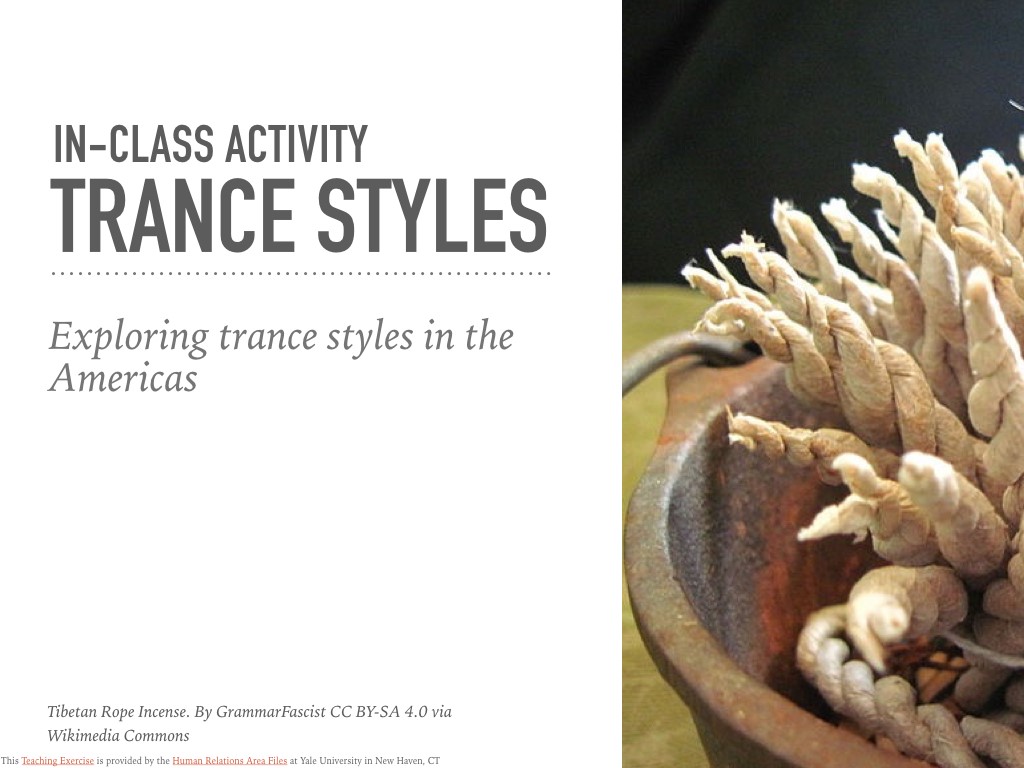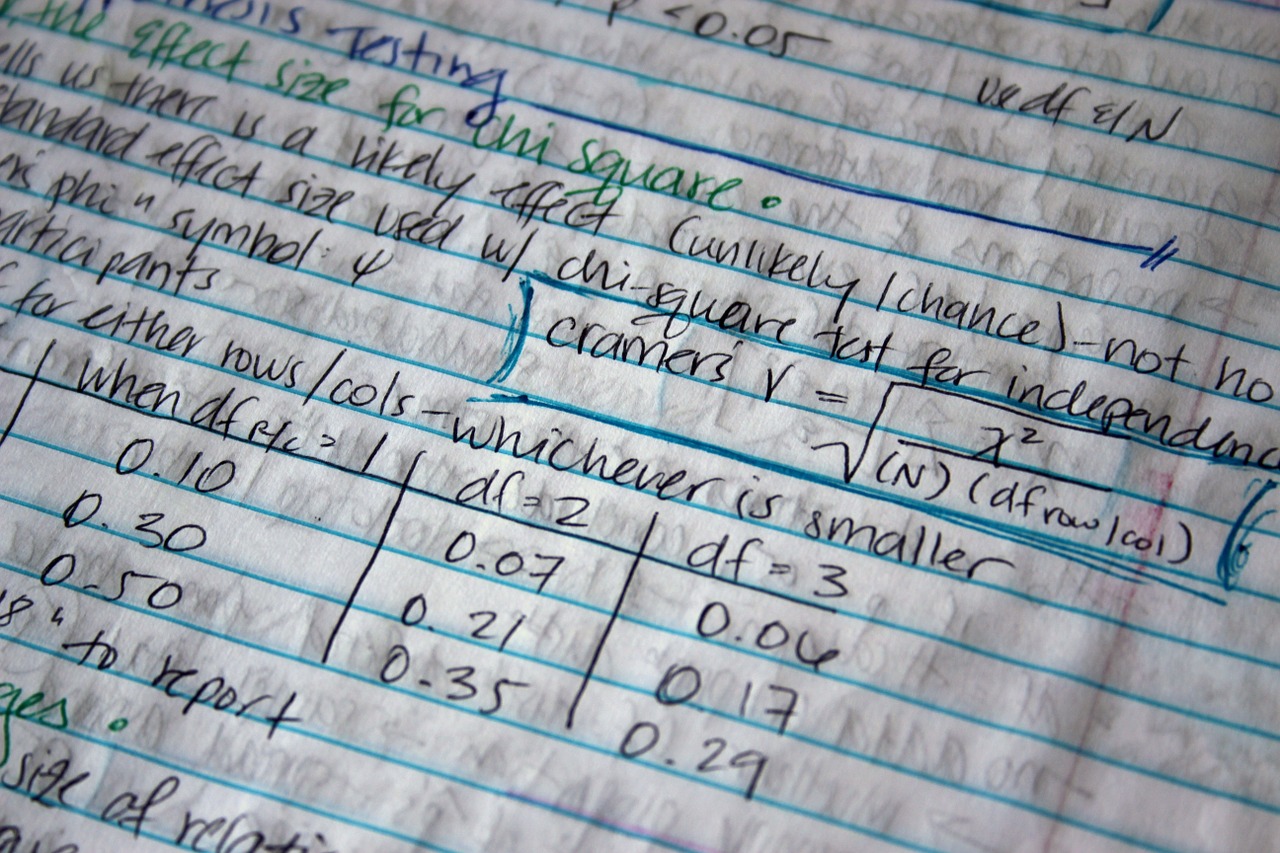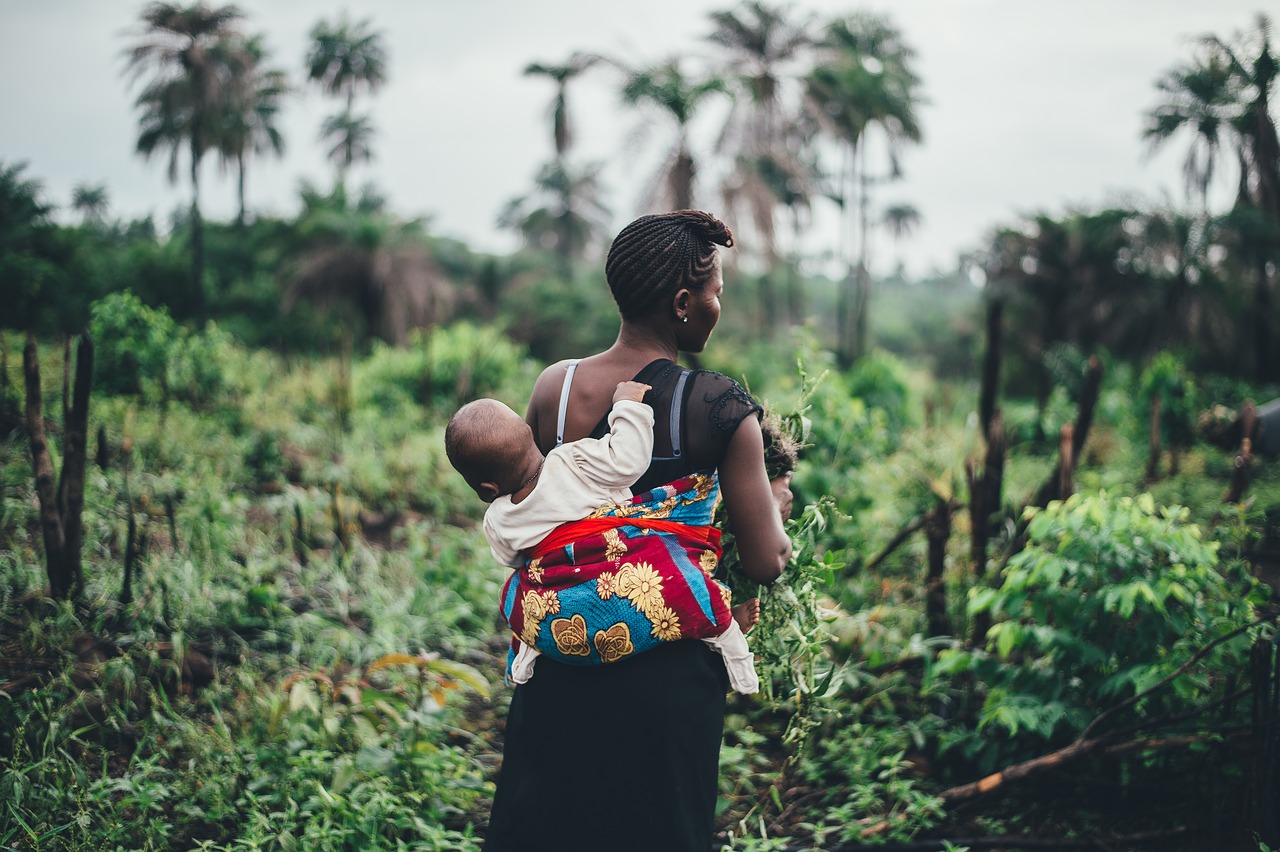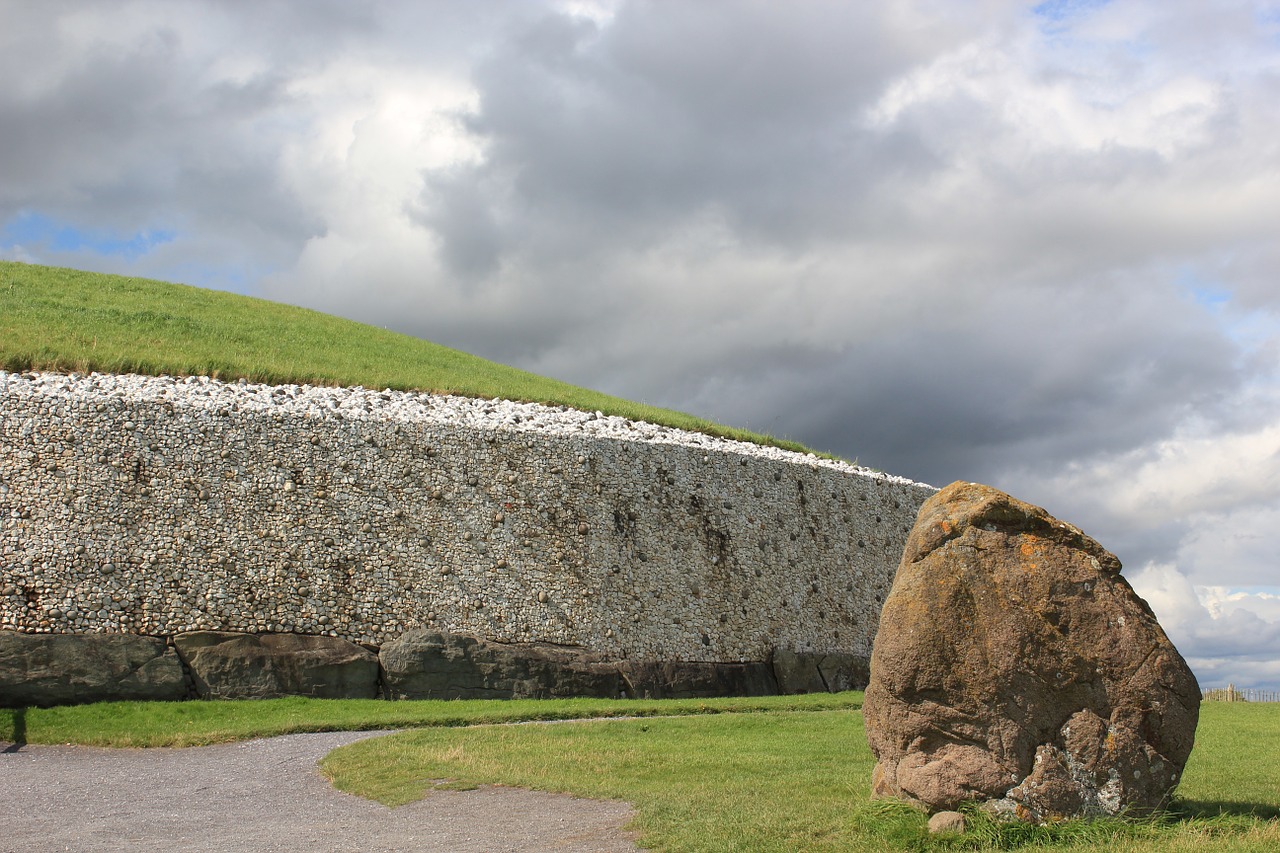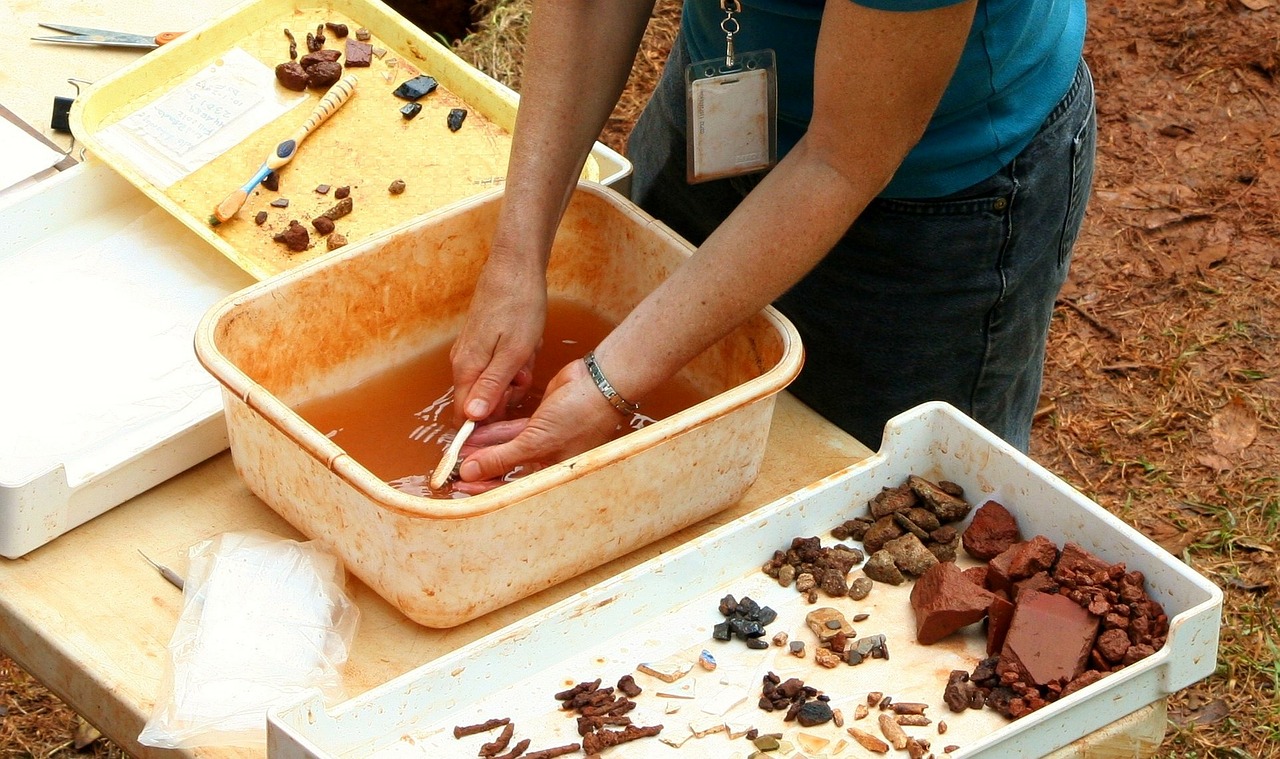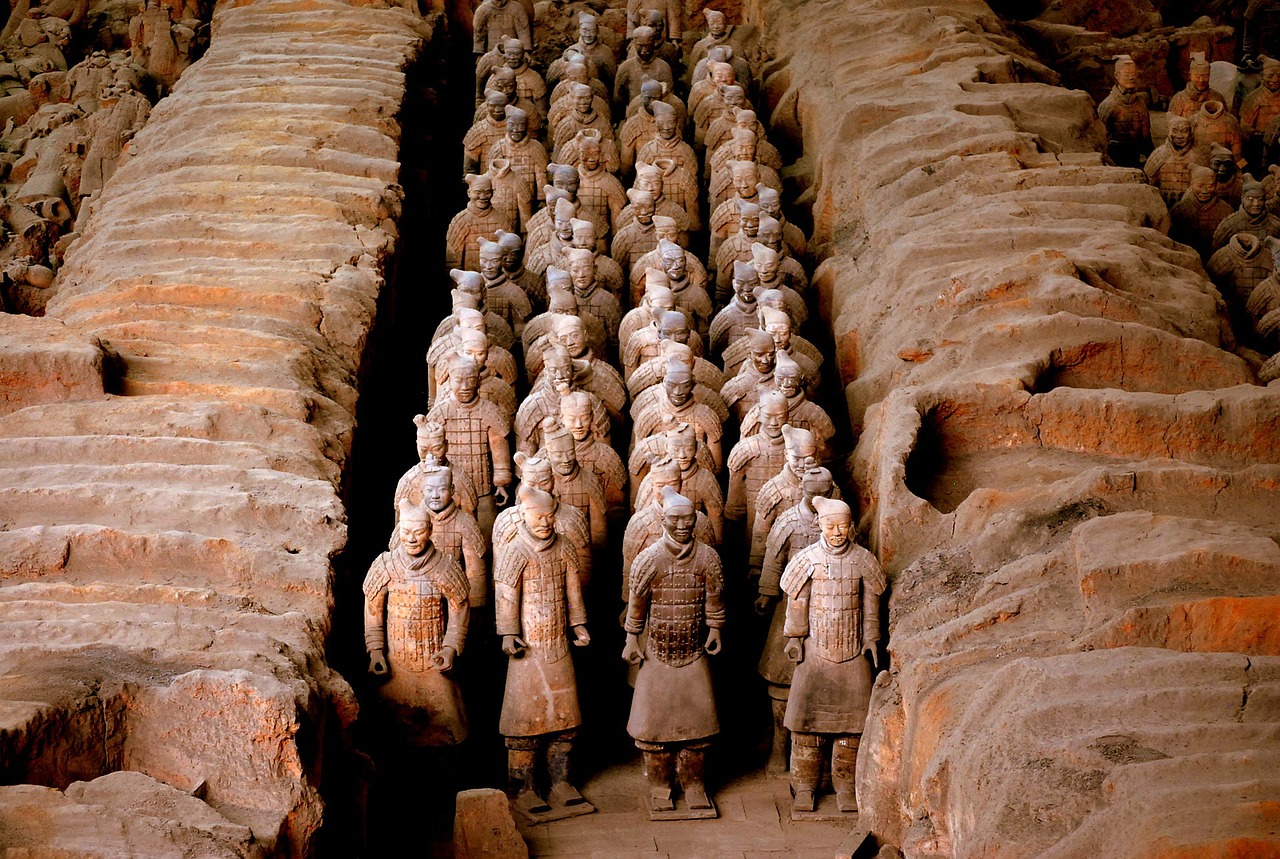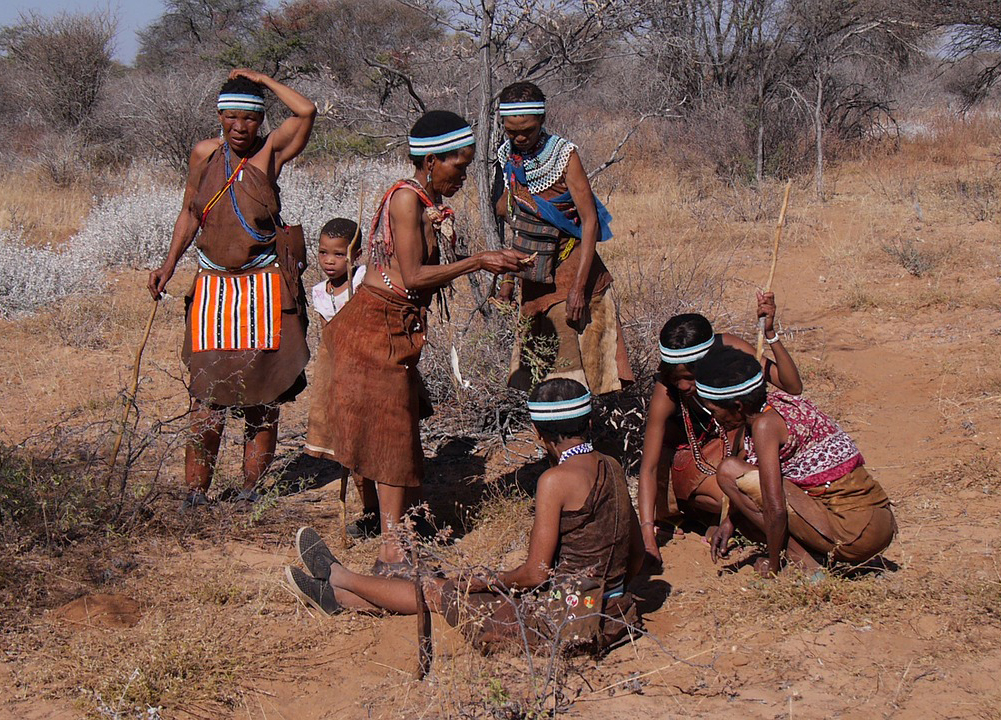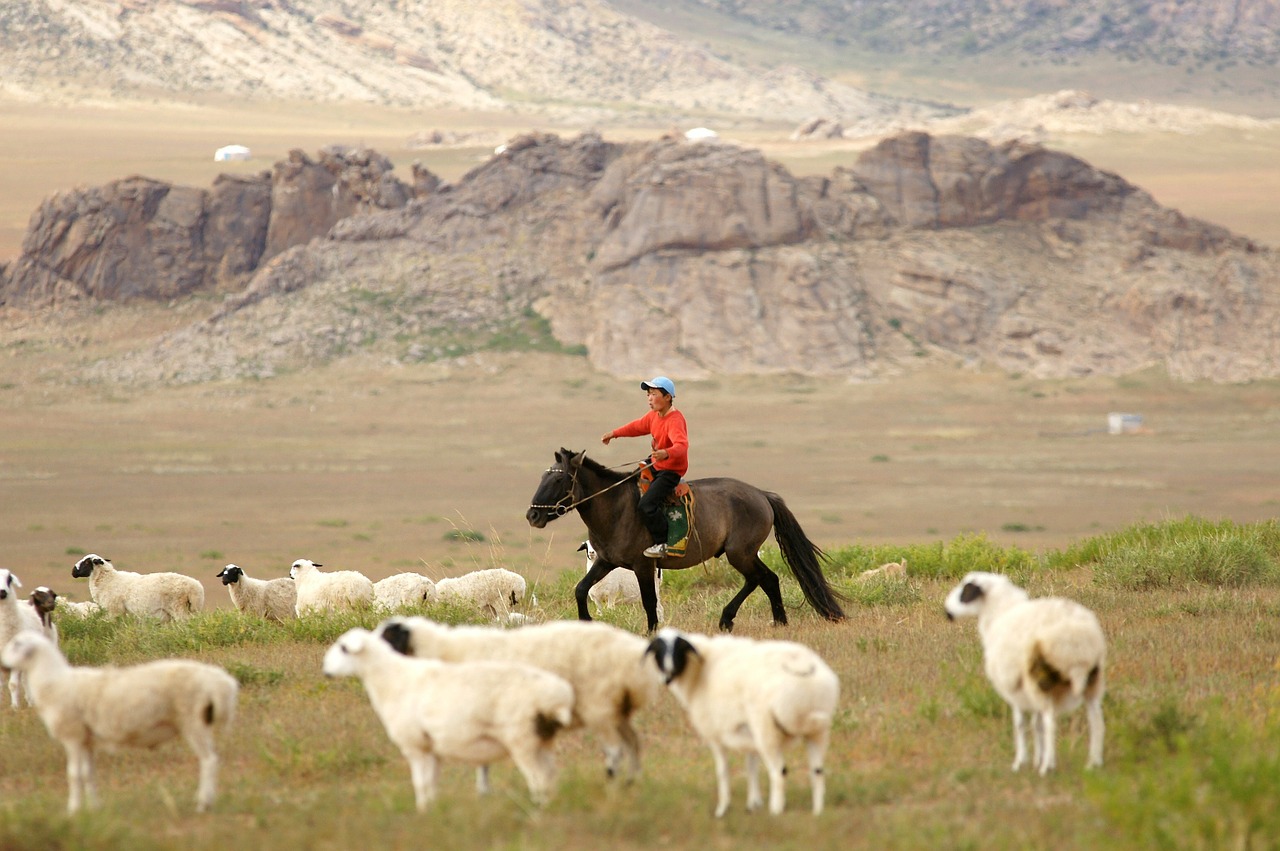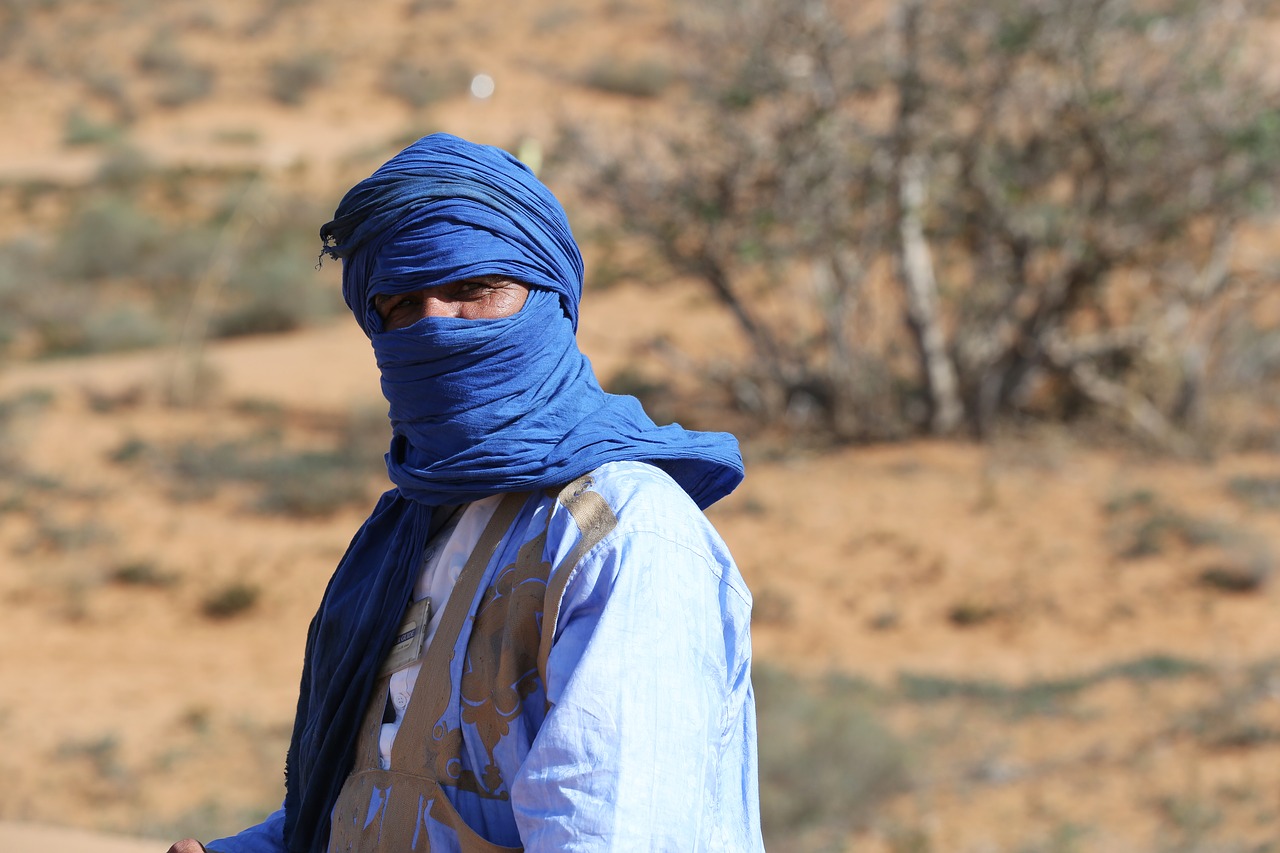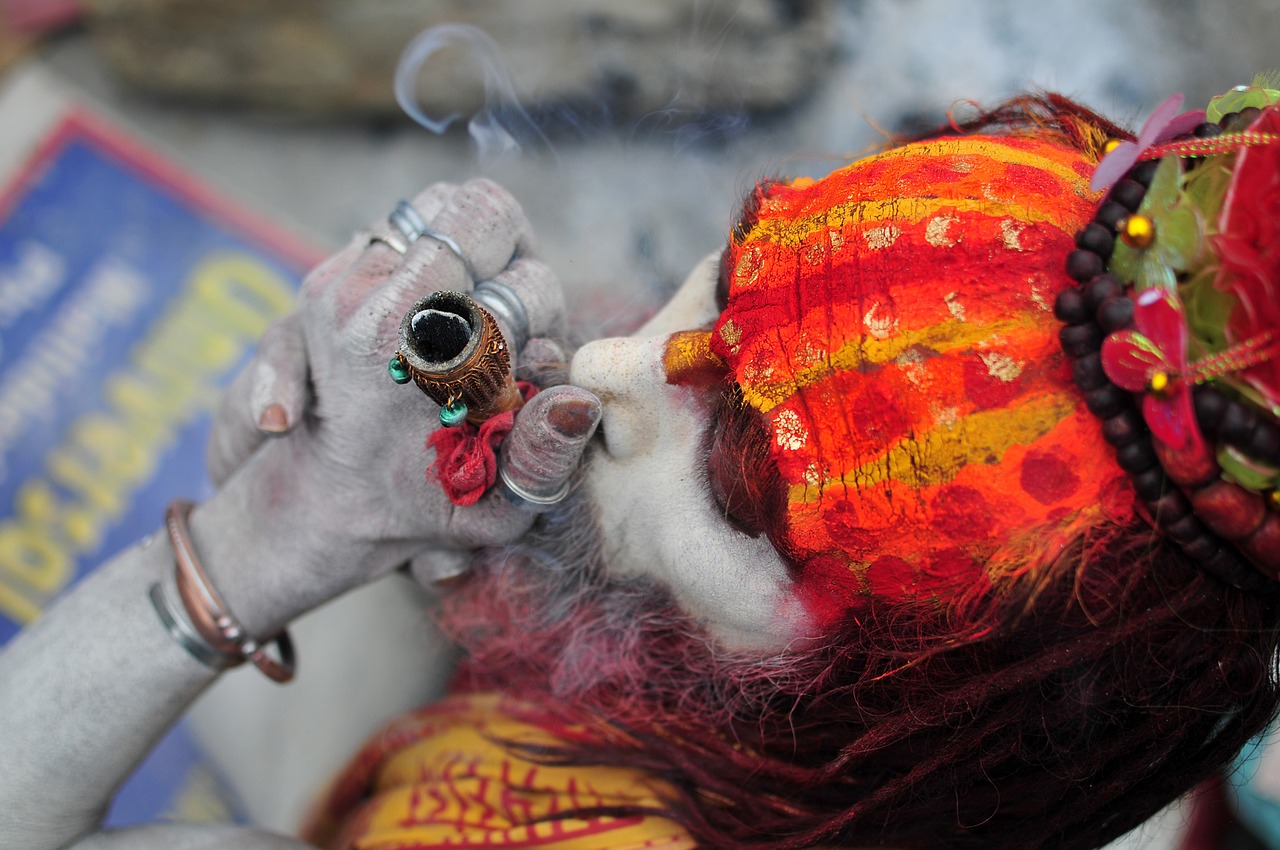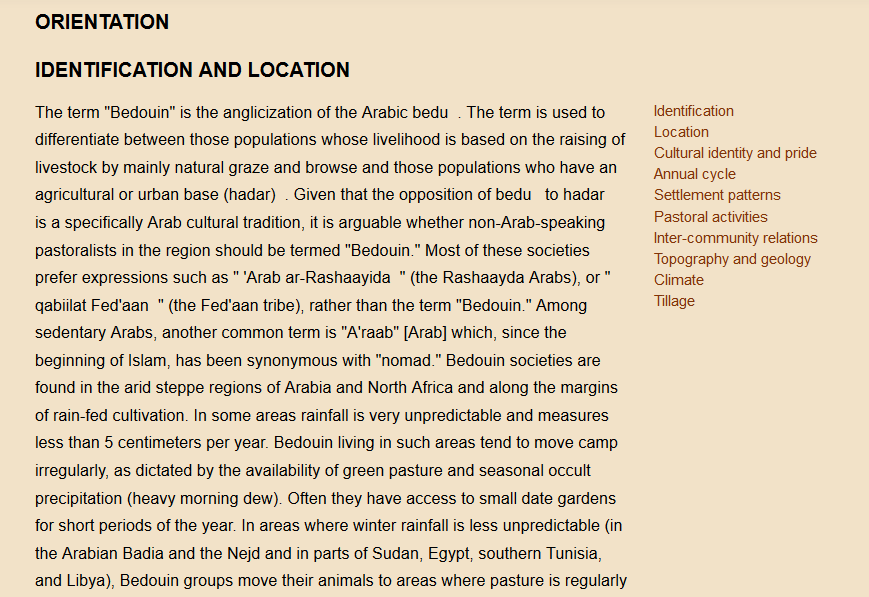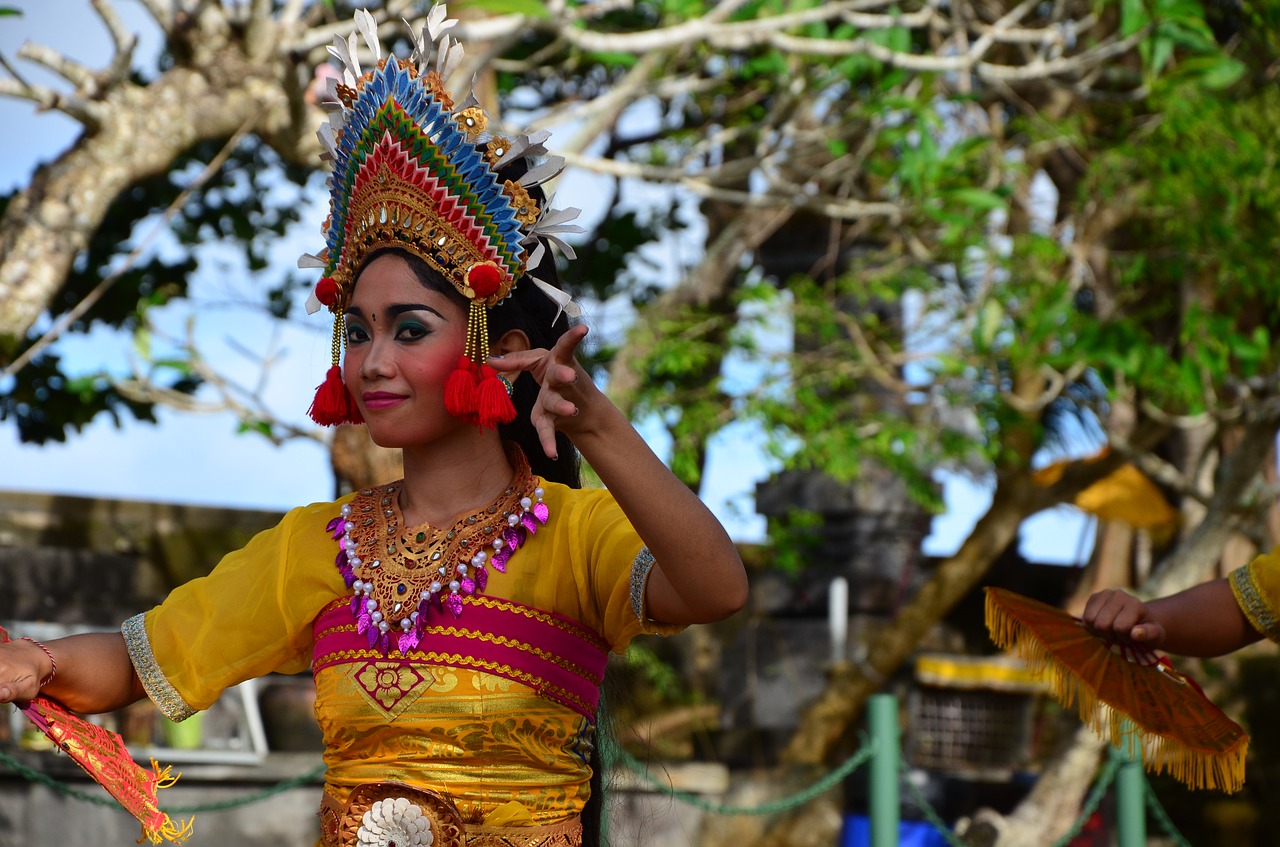Interview Paper: Thinking Through an Interview Guide
Students analyze how diversity affects interactions with major societal institutions (such as health care, criminal justice, education, employment, voting, military) from contemporary and/or historical perspectives.
|
Status and Role of the Elderly (Explaining Human Culture)
These exercises are intended to be used in conjunction with the summary module, Status and Role of the Elderly that is part of Explaining Human Culture. The ethnographic passages that are referred to are found in eHRAF World Cultures, a database of information, primarily collected by anthropologists, about the cultures of the world.
|
Environmental Archaeology
Ethnographic sources are central to many archaeological interpretations of past behaviors, events, and processes. By the end of this project, you will be able to: 1) Navigate the eHRAF databases and conduct detailed searches of its sources Investigate human-environmental interaction in ethnographic sources 2) Assess the value and relevance of ethnographic data for archaeological research and 3) Make controlled comparisons within and among cultures.
|
Residence and Kinship (Explaining Human Culture)
This module gives a general picture of what we have learned from cross-cultural research about variation in kin groups, rule of descent, kinship terminology systems, where couples live after marriage, consequences and predictors of marital residence, and why descent or residence practices may change over time.
|
Marriage and Family (Explaining Human Culture)
These eHRAF Teaching exercises are designed to accompany the Marriage and Family module in Explaining Human Culture. They are intended to convey both the range of cross-cultural variation and outline ways of considering and engaging with that information.
|
Ethics in Archaeology
Museums hold incredible pieces of our shared past, including artwork, pottery, tools, fossils and even the skeletons of animals and humans. They are important public institutions as well as centers for scientific research and discovery. Many museum-goers rarely consider the question, “who owns the past?”
|
eHRAF Archaeology Jeopardy Game
eHRAF Archaeology Jeoparody is an introductory archaeology class activity based on HRAF and the eHRAF Archaeology database. The game runs in a fun, animated PowerPoint format complete with sound effects, transitions, and a “Final Jeoparody” round.
|
Relative and Absolute Dating Methods in Archaeology
Archaeologists use dating methods to build a better picture of how humans lived in the past, as well as how humanity, culture, and societies evolved over time.
|
Introduction to Anthropology
The biological and cultural development of humans from their origin to the present. A brief survey of human evolution is followed by a comparative study of behavior and beliefs of our own and other societies.
|
Language, Culture & Society
Human culture and language are deeply intertwined. Anthropologists would have difficulty understanding a culture without becoming familiar with its language and vice versa. In fact, neither one can exist without the other.
|
An Introduction to Fieldwork and Ethnography
Ethnographic fieldwork is how anthropologists gather data. Fieldwork is the process of immersing oneself in as many aspects of the daily cultural lives of people as possible in order to study their behaviors and interactions.
|
Introducing Culture
Culture represents shared norms, values, ideas and patterns of learned behavior. Because culture is learned, it is both symbolic and ever-changing. It is also adaptive, which means it allows populations to respond to environmental changes as well as social ones.
|
Nascent Worlds
The idea behind Nascent Worlds is for students of anthropology to imagine themselves as ethnographers encountering an entirely distant culture for the first time. What would they discover at this moment of first contact? Over time, by exploring the different areas of life in that society, the alien anthropologist must file a report with an intergalactic board of ethnographers. Who are these beings, and what has been learned about their culture?
|
Reciprocity & Exchange: The Kula Ring
Broadly speaking, economic anthropology is concerned with the ways in which humans “make a living” in different societies or cultures. All societies in the world – industrialized or non-industrialized – have some kind of economic system.
|
HRAF Jeoparody Game
HRAF Jeoparody is an interactive class activity based on the Human Relations Area Files and the eHRAF Databases. The game runs in a fun, animated PowerPoint format complete with sound effects, transitions, and a “Final Jeoparody” round.
|
Ethnographic Insights Across Cultures
Through the comparative study of different cultures, anthropology explores the most fundamental questions about what it means to be human. Drawing upon eHRAF World Cultures and eHRAF Archaeology, this introductory course encourages students to explore cultural similarities and differences to better understand how culture shapes who we are: our societies, our shared meanings, and our everyday lives.
|
Art (Explaining Human Culture)
These exercises are designed to accompany the Explaining Human Culture: Art module which encompasses a range of cross-cultural research on both visual and verbal arts including trends based on degree of societal complexity, the effects of certain child-rearing practices, universals in music, and trends within folktales.
|
ANTH 1500 Great Discoveries in Archaeology
Great Discoveries in Archaeology is a survey of important discoveries in archaeology spanning the whole of human prehistory across the globe. The course also covers current issues, methods, and techniques in the field of archaeology.
|
ANTH 1000W Peoples and Cultures of the World
Other People’s Worlds is a general education course that provides an introduction to cultural anthropology. The course also examines diverse lifeways and social structure among societies found today around the world.
|
Gender (Explaining Human Culture)
These exercises are designed to accompany the Explaining Human Culture: Gender module which encompasses a range of cross-cultural research sexuality including variations in gender concepts, division of labor by gender, differences in gender status, and differences in gender roles in politics / warfare.
|
Ethnographic and Ethnological Research Project
This is a three-part research project in which students choose a cultural behavior and compare it across three cultures: two nonlocal cultures in which they read about the behavior and a third local culture in which they study it in-person.
|
Sexuality (Explaining Human Culture)
These exercises are designed to accompany the Explaining Human Culture: Sexuality module which encompasses a range of cross-cultural research sexuality including homosexuality, premarital sex, marital sex, extramarital sex, restrictions and sex taboos, and sexual double standards.
|
Religion (Explaining Human Culture)
These eHRAF exercises are designed to accompany the Religion Module: Explaining Human Culture, which summarizes what cross-cultural research tells us about predictors and possible explanations of religious variation.
|
Adolescence (Explaining Human Culture)
These eHRAF exercises are designed to accompany the Adolescence module in Explaining Human Culture, which gives a general picture of what we have learned from cross-cultural research about adolescents and the various theories that may explain cultural similarities or difference.
|
Altered States Compared In-Class Activity
In this exercise, students will gain experience interpreting ethnographic case reports addressing altered states of consciousness in two societies, and situating these within ethnographic trance typologies.
|
Sexuality In-Class Activity
In this activity, students will conduct basic research on the diversity of social attitudes towards premarital sexual relations across the globe.
|
Hunter Gatherers & Agriculturalists In-Class Activity
In this exercise, students will compare and contrast social and political dimensions of life between a Native American hunter-gatherer group and an agricultural group.
|
Work in Skins in North America In-Class Activity
In this assignment, students will research strategies for working in skins in North America, and synthesize this data by extrapolating the material evidence hide-working practices might leave in the archaeological record.
|
Work in Skins Worldwide In-Class Activity
In this exercise, students will compare methods, materials, and tools used by societies across the world to work in animal skins
|
Marriage & Choice In-Class Activity
In this exercise, students will read and analyze the concept of marital choice among a variety of societies across the globe.
|
Hunter-Gatherers In-Class Activity
In this exercise, students will break into groups and compare social factors correlated with hunter gatherer subsistence systems.
|
Ethnobotany In-Class Activity
This exercise asks students to explore ethnobotanical practices related to a chosen plant across the world.
|
Dwellings In-Class Activity
In this exercise, students will explore the differences in dwelling size between matrilocal and patrilocal households.
|
Trance In-Class Activity
This exercise allows students to read, compare, and contrast ethnographic work on Middle America and Caribbean trance practices. A downloadable PDF activity sheet is available.
|
Childhood (Explaining Human Culture)
These exercises are designed to accompany the module Childhood in Explaining Human Culture. The module gives a general picture of what we have learned from cross-cultural research about childhood, including kin relations, socialization practices, and gender differences in child behavior.
|
|
|
|
Tattooing and Cross-Cultural Research, Part 4: Outline of a Conference Paper
|
Tattooing and Cross-Cultural Research, Part 3: Outline of a Cross-Cultural Study Paper
|
Tattooing and Cross-Cultural Research, Part 2: Outline of Basic Steps
|
Tattooing and Cross-Cultural Research
Students will learn the basic techniques of cross-cultural survey research, and then apply these techniques while working on their own research project using the Human Relations Area Files as a database.
|
Cross-Cultural Comparison with eHRAF World Cultures
In this course, students will be introduced to formal approaches (methods) used to describe and analyze the social world (social research). An introduction is provided to both qualitative and quantitative methodologies, including the use of descriptive statistics and computer research technologies. As research method students are “apprentice researchers,” an emphasis will be placed on ethical considerations of the research process.
|
Project #3: Group Poster Presentation
The main goal of this exercise is to develop and present research posters based on the cross-cultural data collected during Project #2.
|
Project #2: HRAF Data Recovery (requires SPSS)
The main goal of this project is to develop a cross-cultural data set to be used in Project #3. In order to attain this goal, students first need to generate hypotheses that can be tested with cross-cultural data, and develop conceptual and operational definitions of the hypotheses’ variables.
|
Project #1: Research Questions and Hypotheses
The main goals of this exercise are: 1) to reinforce knowledge about the fundamental concepts of research, 2) start thinking about the cross-cultural research project undertaken throughout the course, and 3) become familiar with eHRAF World Cultures. Topics include Residence, Puberty & Initiation, and Arranging a Marriage.
|
Short Paper on Nutrition (OCM 146)
The goal of this project is for students to do research on the topic of nutrition using eHRAF World Cultures (eHRAF).
|
Reproductive Health
Using the eHRAF World Cultures database, compare and contrast reproductive stages across cultures.
|
Causes of Disease
In places where there is great cultural diversity, it is important for medical staff to understand and be aware of cultural differences in order to treat patients effectively.
|
Topics in Medical Anthropology
The following exercises are designed to find illness causation and medicinal treatments across cultures using eHRAF World Cultures.
|
Hide Working and Tanning Leather
Cross-cultural exercises on hide working and tanning allow students to explore the ethnographic record on leather and related tasks in eHRAF.
|
Burial Practices: an eHRAF workbook for introductory archaeology courses
These exercises, designed for in-class use or as homework assignment in an introductory archaeology course, are linked to data in eHRAF World Cultures and eHRAF Archaeology. The purpose of the workbook is to give the students a feel for archaeological regional differences and an understanding of the structure and functionality of the eHRAF databases.
|
Overview of Archaeological Traditions
This exercise is designed for students to gain a better general understanding of archaeological traditions in terms of their locations, settlement systems, subsistence, relative time periods and other cultural markers.
|
General Archaeology Research Project
This high-school level archaeological project contains four parts: an oral aspect, physical aspect, power point presentation and speeches.
|
Altered States of Consciousness (Explaining Human Culture)
These eHRAF exercises are designed to accompany the module Altered States of Consciousness in Explaining Human Culture. After reviewing evidence for practices involving altered states of consciousness (ASC) in prehistory, the module gives a general picture of what we have learned from cross-cultural research about ASCs, from trances and their frequency, predictors of variation in types of trances, vision quests, and dreaming and out-of-body experiences.
|
Kinship and Land Use
In the Marshall Islands, plots of land are shared by kin group members.This assignment uses a specific textual description available in the eHRAF World Cultures database about taro plots and how they are distributed to kin group members.
|
Kinship and Egalitarian Principles Using the eHRAF World Cultures Database and the HRAF Homepage
Among the Hopi, clan membership is very important for a number of reasons. For this assignment, students will be using a specific textual description available in the eHRAF World Cultures database that describes Hopi kinship and clan life. They will also encounter a discussion about egalitarianism that they will need to assess.
|
Dwellings (Explaining Human Culture)
These eHRAF exercises are designed to accompany the Dwellings Module: Explaining Human Culture which gives a general picture of what we have learned from cross-cultural research about predictors of dwellings from their shape, size and building materials. Such predictors are expected to be most useful to archaeologists wishing to find cultural indicators of cultural and social life from remains of dwellings.
|
Hunter-Gatherers (Explaining Human Culture)
These exercises are designed to accompany the Explaining Human Culture: Hunter-Gatherers module which gives a general picture of what we have learned from cross-cultural research on hunter-gatherers, or more precisely, what we think we know, and to point out some of the things we do not yet know.
|
Exercises Using eHRAF World Cultures
Broadly, these exercises are designed to give you not only a feeling for the range of cultural variation, but also to get a feeling for different methodological approaches in anthropology. Some of the exercises are designed to replicate cross-cultural generalizations; others to explore one or more cultures.
|
Bizarre Foods
Through in-class activities, group work, and illustrated lectures (including segments from hit TV shows ‘Bizarre Foods’ and ‘Without Reservation’) this course examines “bizarre foods” and the cultural links they involve.
|
Eating Salt and Symbols: Exploring the Relationship of Biology and Culture with eHRAF
The intention of this assignment is to illustrate principles of scientific method by using the eHRAF World Cultures database to explore the relationship between diet and attitudes toward salt.
|
Culture and Aging: A Research Project in Completed Fertility & Subsistence Practices, Productivity & Aging, and Social Networks & Aging
The challenge in this study of the cultural context of aging is to develop an understanding of how different ecological and social conditions are related to variation in the pattern and process of aging and passage through the lifecourse.
|
Library Assignment: Finding Anthropological Resources
This exercise gives students a choice between an ethnographic (focusing on a single culture) or ethnological (cross-cultural) approach to research using eHRAF World Cultures.
|
Cross-Cultural Correlation Study
For this assignment, students create a 5-7 page paper investigating some aspect of cultural anthropology.
|
Ritual Kinship: A Short Paper
The subject of this exercise is the function of ritual kinship in a non-western society.
|
Political Function of a Religious Institution: A Short Paper
The subject of this exercise is the political function of any religious institution in a non-western society of the student’s choosing.
|
Ecological Function of a Behavioral Institution in a Pastoral or Horticultural Society: A Short Paper
The subject of this exercise is the cultural ecological function of a behavioral institution in a pastoral or horticultural society.
|
Ecological Function of a Behavioral Institution in a Nomadic Society: A Short Paper
The subject of this exercise is the cultural ecological function of a behavioral institution in a non-Western nomadic society.
|
Basic Cross-Cultural Research Assignment
The purpose of this assignment is to become familiar with the contents and structure of the eHRAF World Cultures by learning to navigate around the database and by performing searches on topics of the students’ choice.
|
Explorations in Cross Cultural Anthropology, Pt3: eHRAF Assignments
|
Explorations in Cross Cultural Anthropology, Pt 2: Ethnographic Outline
|
Explorations in Cross-Cultural Anthropology Part 1: Syllabus
Sociocultural anthropology provides ways of seeing other peoples and cultures in their own terms. In this course, students will learn how anthropologists see the world and how anthropologists analyze and explain cultures.
|
A Cross-Cultural Study of Violence
Using the ethnographies from assigned literature and eHRAF World Cultures, this exercises explore violence cross culturally and tries to determine, through careful comparisons, if there are any general explanations for violence.
|
Native Peoples of South America: A Comparative Ethnography
This project is used in an anthropology course on the Native Peoples of South America. The questions were written to match the topics covered in Betty Meggers’ Amazonia: Man and Culture in a Counterfeit Paradise (Smithsonian Institution, 1996).
|
Short Paper on Sacred Objects & Places (OCM 778) and on Animism (OCM 774)
Exercise for writing a paper that discusses Sacred Objects and Places (OCM 778) in one culture, and Animism (OCM 774) in another culture.
|
Short Paper on Basis of Marriage (OCM 581) and Arranging a Marriage (OCM 584)
Exercise for writing a paper that discusses the search results in ethnographic texts for the subjects Basis of Marriage (OCM 581) in one culture and Arranging A Marriage (OCM 584) in another culture.
|
Overview of Cultures & Ethnic Groups in Culture Summaries
General topics with focus on eHRAF’s Browse Cultures and Culture Summaries.
|
Ethnology and Ethnography in Anthropology
This eHRAF assignment contains a group presentation and individual paper.
|
Understanding Ethnography: An eHRAF Workbook for Introductory Anthropology Courses
The purpose of the workbook is to give students a feel for ethnographic data, which should help their understanding of anthropological concepts and theories. Includes diverse topics in anthropology such as kinship, cosmology, witchcraft, storytelling, feuding, etc.
|
Introduction to Cultural Anthropology: A Syllabus
Guidelines for writing a student paper using eHRAF World Cultures.
|
Student Paper Guidelines for Using eHRAF: One Professor's Experience
Useful tips for faculty using eHRAF World Cultures for student assignments.
|
|




